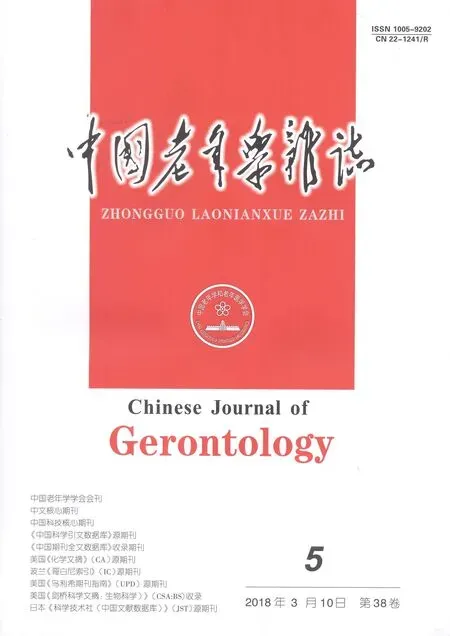microRNA-107在阿爾茨海默病患者血清中的表達及臨床意義
曾慶宏 劉 霞 莊愛霞 周 芳 于善花 姜建東 王傳淇 彭艷艷 張浩江 聶紅霞
(連云港市第二人民醫院神經內科,江蘇 連云港 222006)
阿爾茨海默病(AD)是一種神經退行性疾病,表現為認知、語言、記憶等功能障礙〔1~3〕,是導致老年人癡呆的主要原因〔4〕。近年來一些新技術的開發應用,促進了蛋白組學的研究,基質輔助激光解析電離-飛行時間質譜(MALDI-TOF/TOF MSS)〔5〕,高效液相色譜與電感耦合等離子質譜(HPLC-ICP-MS)〔6〕,液相色譜-紫外光譜-質譜聯用技術(HPLCUV-MS)〔7,8〕,鳥槍法蛋白質組學〔9〕等對蛋白的分離、定性和定量的檢測,可能有助于新的AD生物標記物的發現,但仍缺乏特異性和敏感性均高的單一的診斷方法。microRNA是真核生物中一類長度約為22個核苷酸的參與基因轉錄后水平調控的單鏈非編碼小分子RNA,主要功能是通過抑制靶mRNA翻譯或促使其降解的方式對基因表達起調控作用〔10〕,參與細胞周期調控及個體發育過程〔11~14〕。在神經系統中microRNAs調節不同發育階段及不同部位的病理生理條件下神經細胞的增殖、分化與凋亡,并對人類的認知和記憶能力的形成起重要作用〔15,16〕。有些microRNAs以與多聚核糖體結合的方式存在于神經元中〔17,18〕,對腦的生長發育表達出組織特異性和階段特異性。血清中存在著穩定的microRNAs表達〔19,20〕。本研究旨在分析microRNA-107在AD患者血清中表達。
1 資料和方法
1.1研究對象 2012年10月至2015年6月連云港市第二人民醫院住院及門診就診首次診斷AD的患者,根據病情程度分為輕度組和中度組各30例;根據年齡匹配設正常組30例:為健康體檢者,具有正常功能活動能力,無器質性腦病,神經系統檢查無異常,簡易精神狀態監測量表(MMSE)評分在28分以上。排除標準:(1)既往有腦血管疾病者;(2)有顱腦外傷者;(3)有中毒性、代謝性等腦病者;(4)診斷前進行藥物治療者;(5)有血液系統疾病者;(6)血管性及其他原因所致癡呆;(7)未知情同意者。記錄所有研究對象的性別、年齡、既往史(高血壓、糖尿病、冠心病等)、吸煙史、飲酒史及纖維蛋白原(Fg)、高半胱氨酸(HHcy)、C反應蛋白(CRP)、血脂等血液化驗指標。三組性別、年齡及既往史差異無統計學意義(P>0.05),具有可比性。見表1。
1.2AD診斷標準 根據2011年美國國家衰老研究所(NIA)和AD學會(AA)制定的診斷標準(NIA-AA診斷標準),AD患者的癡呆分級根據MMSE和AD評定量表認知部分(ADAS-cog)量表。根據MMSE評分分為:輕度組(15分 1.3樣本采集 輕、中度組治療前采取靜脈血,正常組靜脈血來自來體檢中心健康體檢者,所有靜脈血提取血清后放入-80℃冰箱保存備用。 1.4總RNA提取 取100~200 μl低溫冷藏的每例血清樣本,置于冰上融化,且充分混勻。加入3倍體積的Trizol LS到樣本中,在震蕩器上充分混勻,室溫放置5~15 min進行變性處理。按等體積加入氯仿,振蕩器上充分混勻,室溫放置15 min,在4℃條件下,14 000 r/min離心15 min抽提RNA。 1.5芯片檢測 抽取每例輕、中度組患者的等量RNA,充分混勻后抽提RNA進行microRNA芯片檢測,并與正常組的microRNA芯片檢測結果比較,利用軟件找出差異microRNAs。 1.6逆轉錄 用Taqman microRNA逆轉錄試劑盒和microRNA特異性莖環結構逆轉錄引物進行microRNA逆轉錄反應,操作按照ABI的流程,進行部分調整,總反應體系15 μl。 1.7QT-PCR檢測 設計引物序列,以U6 snRNA 作為內參,應用QT-PCR把三組microRNA-107進行定量分析,然后進行相互比較。用2-ΔΔCT計算microRNA的表達量,每例樣本重復檢測3次。 1.8統計學處理 采用SPSS19.0軟件進行t、χ2檢驗和多因素回歸分析。 表1 3組一般資料對比(n=30) 1)正常組與輕度組比較;2)正常組與中度組比較;3)輕度組與中度組比較 2.1基因芯片檢測結果 輕度組檢測出信號表達>500的差異microRNAs 35條,其中上調27條,下調8條,見圖1;中度組檢測出信號表達>500的差異microRNAs 34條,其中上調23條,下調11條,見圖2。輕度組與中度組共同表達>500的差異microRNAs 26條,其中microRNA-107在列。microRNA-107在輕度組、中度組均顯著下調microRNA(P<0.01)。 2.2MicroRNA-107 QT-PCR結果 見表2。輕度組、中度組血清中microRNA-107表達量較正常組明顯下降(P<0.01),與芯片結果一致;中度組血清中microRNA-107表達量較輕度組顯著下降(P<0.01)。 圖1 輕度組與正常組差異microRNAs聚類圖 圖2 中度組與正常組差異microRNAs聚類圖 表2 3組microRNA-107定量結果比較 ΔCT.同一個樣品目標基因和內參基因平均CT值的差值;ΔΔCT.特定目標基因的待檢樣品和校準樣品ΔCT的差值;與正常組比較:1)P<0.01;與輕度組比較:2)P<0.01 microRNAs與腫瘤〔21,22〕、心血管疾病〔23,24〕、糖尿病〔25〕、神經退行性疾病〔26〕的發生發展密切相關,與AD的關系也受到廣泛關注〔27~29〕。有研究者在AD的轉基因小鼠模型里檢測到對AD有影響的microRNAs〔30,31〕。MicroRNAs在細胞實驗中能調節淀粉樣前體蛋白(APP)的表達〔32~34〕及影響Aβ沉積〔35〕。Sohonrook 等〔36〕發現某些microRNAs促進了Aβ產生,而Aβ又可改變microRNAs表達,成為microRNAs網絡失衡的始發因子,MicroRNAs與Aβ之間存在一種極其復雜的聯系,在體內相互促進相互影響,從而影響著AD的發生發展。MicroRNA-125b被證明可引起tau蛋白高度磷酸化,其機制在于靶向抑制雙特異性磷酸酶(DUSP)6和蛋白磷酸酶催化亞基α亞型(PPP1CA)而促進tau蛋白磷酸化,研究同時發現micro-125b可損害小鼠聯合型學習〔37〕。Lau等〔38〕的研究也證明microRNA-132-3p通過調節tau蛋白的轉錄因子促進了AD的發展。可見,MicroRNAs從多種機制上參與了AD的發生、發展。 本研究結果說明microRNA-107下調可能影響AD的發生。MicroRNA-107是microRNA-15/107家族成員之一,這個家族的其他成員還包括microRNA-15,microRNA-16,microRNA-103,microRNA-195,microRNA-424,microRNA-497,microRNA-503,microRNA-646等,這些microRNAs的5′端都有相同的種子序列AGCAGC,正是由于這種5′端序列的同源性促使其在調控靶mRNA的轉錄后降解和翻譯抑制方面有相似的特性〔39〕。目前這個家族中microRNA-107已證實與AD的發生相關〔40〕,Nelson 等〔41〕發現AD和輕度認知功能障礙(MCI)的患者中microRNA-107表達水平下降,與本研究結果一致。Petra等〔42〕研究了血液中12種與AD有關的microRNAs,其中microRNA-107也表達下降。MicroRNA-107可能通過以下相關機制影響AD的發生發展:(1)Wang等〔43〕對不同階段AD患者腦組織中的RNA進行分析,發現AD進程中microRNA-107的表達出現不同程度減少,而淀粉蛋白前β位分解酶(BACE)1表達增加,從而出現相應的病理改變,該研究認為microRNA-107可通過與靶基因BACE1的3′端非翻譯區(UTR)區結合調控BACE1的表達,繼而增加APP水解后Aβ生成與沉積導致AD的發生,并可能通過調節BACE1參與加速該病的進展;(2)MicroRNA-107也可以誘導神經元細胞周期阻滯〔44〕,并重新進入細胞周期,重新進入細胞周期是AD發病的早期事件甚至發生在Aβ和神經纖維纏結(NFTs)形成之前〔45〕,導致AD的發生;(3)MicroRNA-107還通過降低控制APP和淀粉樣斑塊形成解聚素基質金屬蛋白酶(ADAM)10的表達來影響AD的發生〔46〕;(4)Peter等〔47〕還證實AD患者腦組織microRNA-107表達下降與老年斑及NFTs下降相關。當然,microRNA-107影響AD的機制還需要進一步的研究。 綜上,血清中microRNA-107可能間接反映腦組織內的microRNA-107表達變化,但AD患者血清中表達水平下降的原因和機制尚需進一步研究。microRNA-107可能會作為輔助診斷AD的一種潛在的生物標志物,為AD提供更全面的早期診斷及判斷預后指標,并且可能成為治療靶點,但microRNA-107表達水平與AD的診斷是否具有特異性,尚需進一步擴大樣本量進行驗證。 1Ballard C,Gauthier S,Corbett A,etal.Alzheimer′s disease〔J〕.Lancet,2011;377(9770):1019-31. 2Galimberti D,Scarpini E.Progress in Alzheimer′s disease〔J〕.J Neurol,2012;259(2):201-11. 3Delay C,Mandemakers W,Hebert SS.MicroRNAs in Alzheimer′s disease〔J〕.Neurobiol Dis,2012;46(2):285-90. 4Blennow K,Leon MJ,Zetterberg H.Alzheimer′s disease〔J〕.Lancet,2006;368(9533):387-403. 5Taki T.An approach to glycobiology from glycolipidomics:ganglioside molecular scanning in the brains of patients with Alzheimer′s disease by TLC-blot/matrix assisted laser desorption/ionization-time of flight MS〔J〕.Biol Pharm Bull,2012;35(10):1642-7. 6Yang MH,Yang YH,Lu CY,etal.Activity-dependent neuroprotector homeobox protein:a candidate protein identified in serum as diagnostic biomarker for Alzheimer′s Disease〔J〕.J Proteomics,2012;75(12):3617-29. 7Czech C,Bemdt P,Busch K,etal.Metabolite profiling of Alzheimer′s disease cerebrospinal fluid〔J〕.PLoS One,2012;7(2):e31501. 8Hu ZP,Browne ER,Liu T,etal.Metabonomic profiling of TASTPM transgenie Alzheimer′s disease mouse model〔J〕.J Proteome Res,2012;11(12):5903-13. 9Han X,Rozen S,Bovle SH,etal.Metabolomics in early Alzheimer′s disease:identification of altered plasma sphingolipidome using shotgun lipidomits〔J〕.PLoS One,2011;6(7):e21643. 10Krol J,Loedige I,Filipowicz W.The widespread regulation of microRNA biogenesis,function and decay〔J〕.Nat Rev Genet,2010;1l:597-610. 11Harfe BD.MicroRNAs in vertebrate development〔J〕.Curr Opin Genet Dev,2005;15(4):410-5. 12Tanzer A,Stadler PF.Molecular evolution of a microRNA cluster〔J〕.J Mol Biol,2004;339(2):327-35. 13Valencia-Sanchez MA,Liu J,Hannon GJ,etal.Control of teanslation and microRNA degradation by microRNA and siRNAs〔J〕.Genes Dev,2006;20:515-24. 14Presutti C,Rosati J,Vincenti S,etal.Non coding RNA and brain〔J〕.BMC Neurosci,2006;7(Suppl 1):S5. 15Cohen JE,Lee PR,Chen S,etal.MicroRNA regulation of homeostatic synaptic plasticity 〔J〕.Proc Natl Acad Sci U S A,2011;108(28):11650-5. 16Can J,Wang WY,Mao YW,etal.A novel pathway regulates memory and plasticity via SIRT1 and miR-134〔J〕.Nature,2010;466(7310):1105-9. 17Kim J,Krichevsky A,Grad Y,etal.Identification of many microRNAs that copurify with polyribosomes in mammalian neurons〔J〕.Proc Natl Acad Sci U S A,2004;101(1):360-5. 18Krichevsky AM,King KS,Donahue CP,etal.A microRNA array reveals extensive regulation of microRNAs during brain development〔J〕.RNA,2003;9(10):1274-81. 19Mo MH,Chen L,Fu Y,etal.Cell-free Circulating miRNA biomarkers in cancer〔J〕.J Cancer,2012;3(4):432-4. 20Resnik KE,Alder H,Hagan JP,etal.The detection of differentially expressed microRNAs from the serum of ovarian cancer patients using a novel real-time PCR platform〔J〕.Gynecol Oncol,2009;112(1):55-9. 21Song YQ ,Ma XH,Ma GL,etal.MicroRNA-107 promotes proliferation of gastric cancer cells by targeting cyclin dependent kinase 8〔J〕.Diagn Pathol,2014;9:164. 22Zhong KZ,Chen WW,Hu XY,etal.Linicopathological and prognostic significance of microRNA-107 in human non small cell lung cancer〔J〕.Int J Clin Exp Pathol,2014;7(7):4545-51. 23Suvi MK,Juha H,Mikko H,etal.MicroRNA Profiling of Pericardial Fluid Samples from Patients with Heart Failure〔J〕.PLoS One,2015;10(3):e0119646. 24Bao MH,Feng X,Zhang YW,etal.Let-7 in cardiovascular diseases,heart development and cardiovascular differentiation from stem cells〔J〕.Int J Mol Sci,2013;14(11):23086-102. 25Kurtz CL,Peck BCE,Fannin EE,etal.MicroRNA-29 fine-tunes the expression of key FOXA2-activated lipid metabolism genes and is dysregulated in animal models of insulin resistance and diabetes〔J〕.Diabetes,2014;63(9):3141-8. 26Junn E,Mouradian MM.MicroRNAs in neurodegenemtive diseases and their therapeutic potential〔J〕.Pharmacol Ther,2012;133(2):142-50. 27Wong HK,Veremeyko T,Patel N,etal.De-repression of FOX03a death axis by microRNA-132 and-212 causes neuronal apoptosis in Alzheimer's disease 〔J〕.Hum Mol Genet,2013;22(15):3077-92. 28Bhatnagar S,Chertkow H,Schipper HM,etal.Increased microRNA-34c a bundance in Alzheimer′s disease circulating blood plasma〔J〕.Front Mol Neurosci,2014;7(1):2. 29Long JM,Ray B,Lahiri DK.Lahiri MicroRNA-339-5p down-regulates protein expression of β-site amyloid precursor protein-cleaving enzyme 1(BACE1)in human primary brain cultures and is reduced in brain tissue specimens of alzheimer disease subjects〔J〕.J Biol Chem,2014;289(8):5184-98. 30Hebert SS,Horre K,Nicolai L,etal.MicroRNA regulation of Alzheimer's Amyloid precursor protein expression〔J〕.Neurobiol Dis,2009;33(3):422-8. 31Wang X,Liu P,Zhu H,etal.MiR-34a,a microRNA up-regulated in a double transgenic mouse model of Alzheimer′s disease,inhibits bcl2 translation〔J〕.Brain Res Bull,2009;80(4-5):268-73. 32Long JM,Ray B,Lahiri DK.MicroRNA-153 physiologically inhibits expression of amyloid-beta precursor protein in cultured human fetal brain cells and is dysregulated in a subset of Alzheimer disease patients〔J〕.J Biol Chem,2012;287(37):31298-310. 33Long JM,Lahiri DK.MicroRNA-101 downregulates Alzheimer′s amyloid-β precursor protein levels in human cell cultures and is differentially expressed〔J〕.Biochem Biophys Res Commun,2011;404(4):889-95. 34Vilardo E,Barbato C,Ciotti M,etal.MicroRNA-101 regulates amyloid precursor protein expression in hippocampal neurons〔J〕.J Biol Chem,2010;285(24):18344-51. 35Fang M,Wang J,Zhang X,etal.The miR-124 regulates the expression of BACE1/B-secretase correlated with cell death in Alzheimer′s disease〔J〕.Toxicol Lett,2012;209(1):94-105. 36Sohonrook N,Ke YD,Humphreys D,etal.Neuronal mircoRNA deregulation in response to Alzheimer′s disease amyloid-beta〔J〕.PLoS One,2010;5(6):e11070. 37Banzhaf-Strathmann J,Benito E,May S,etal.MicroRNA-125b induces tau hyperphosphorylation and cognitive deficits in Alzheimer′s disease〔J〕.EMBO J,2014;33(15):1667-80. 38Lau P,Bossers K,Janky R,etal.Alteration of the microRNA network during the progression of Alzheimer′s disease〔J〕.EMBO Mol Med,2013;5(10):1613-34. 39Finnerty JR,Wang WX,Hebert SS,etal.The miR-15/107 group of microRNA genes:evolutionary biology,cellular functions,and roles in human diseases〔J〕.J Mol Biol,2010;402(3):491-509. 40Miiller M,Kuiperij HB,Claassen JA,etal.MicroRNAs in Alzheimer′s disease:differential expression in hippocampus and cell-free cerebrospinal fluid〔J〕.Neurobiol Aging,2014;35(1):152-8. 41Nelson PT,Wang WX.MiR-107 is reduced in Alzheimer′s diseasebrain neocortex:validation study〔J〕.J Alzheimers Dis,2010;21(1):75-9. 42Petra L,Christina B,Stephanie D.A blood based 12-miRNA signature of Alzheimer disease patients〔J〕.Genome Biol,2013;14(7):R78. 43Wang WX,Rajeev BW,Stromberg AJ,etal.The expression of microRNA miR-107 decreases early in Alzheimer′s disease and may accelerate disease progression through regulation of betasite amyloid precursor protein-cleaving enzyme 1〔J〕.J Neurosci,2008;28(5):1213-23. 44Feng L,Xie Y,Zhang H,etal.MiR-107 targets cyclin-dependent kinase 6 expression,induces cell cycle G1 arrest and inhibits invasion in gastric cancer cells〔J〕.Med Oncol,2012;29(2):856-63. 45Bonda DJ,Lee HP,Kudo W,etal.Pathological implications of cell cycle re-entry in Alzheimer′ disease〔J〕.Expert Rev Mol Med,2010;12:e19. 46Augustin R,Endres K,Reinhardt S,etal.Computational identification and experimental validation of microRNAs binding to the Alzheimer-related gene ADAM10〔J〕.BMC Med Genet,2012;14:35. 47Peter TN,Wang XW.MiR-107 is reduced in Alzheimer′s disease brain neocortex:validation study〔J〕.J Alzheimers Dis,2010;21(1):75-9.
2 結 果



3 討 論

